pep7 unit1 第一课时(全英)教案
- 格式:docx
- 大小:521.39 KB
- 文档页数:4
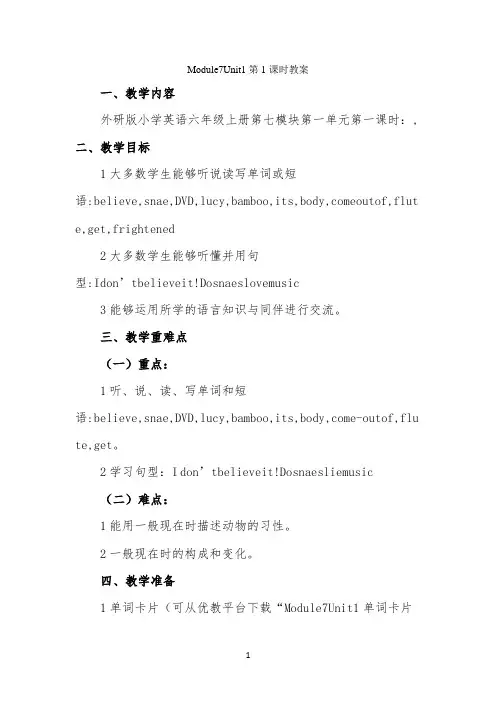
Module7Unit1第1课时教案一、教学内容外研版小学英语六年级上册第七模块第一单元第一课时:,二、教学目标1大多数学生能够听说读写单词或短语:believe,snae,DVD,lucy,bamboo,its,body,comeoutof,flut e,get,frightened2大多数学生能够听懂并用句型:Idon’tbelieveit!Dosnaeslovemusic3能够运用所学的语言知识与同伴进行交流。
三、教学重难点(一)重点:1听、说、读、写单词和短语:believe,snae,DVD,lucy,bamboo,its,body,come-outof,flu te,get。
2学习句型:I don’tbelieveit!Dosnaesliemusic(二)难点:1能用一般现在时描述动物的习性。
2一般现在时的构成和变化。
四、教学准备1单词卡片(可从优教平台下载“Module7Unit1单词卡片集”直接使用)。
2音频(可从优教平台下载使用)。
3人物头饰。
课件。
五、教学设计Ste-u eriddlesaboutanimals1 【设计思路】复习旧知识的同时也为学习新知识做好了铺垫,同时也锻炼了学生的听力,提高他们的学习兴趣。
Ste boo2T:Inowthateanimalsandsaysomethingaboutthem4学习单词:DVD,believe,fantastic用单词卡片学习这三个单词。
T:Loo!DoyounowwhatitisS1:It’saDVDT:Howcleveryouare!IthinyoucanbethelittleteacherReadafterme:DVD板书【设计思路】师生共同创设了一种民主和谐的英语学习气氛,较好地形成了师生互动和生生互动,教师把课堂真正还给学生,让学生成为学习的主人,教师成为学生平等的对话者。
2课文学习。
1T:DoyouwanttonowmorenowledgeaboutusicHowlongdoalleyes,twobigears,’(1)学生练习,表演。

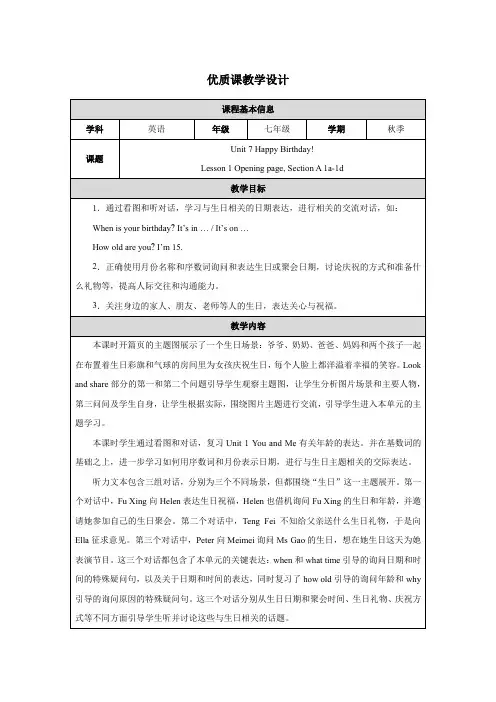
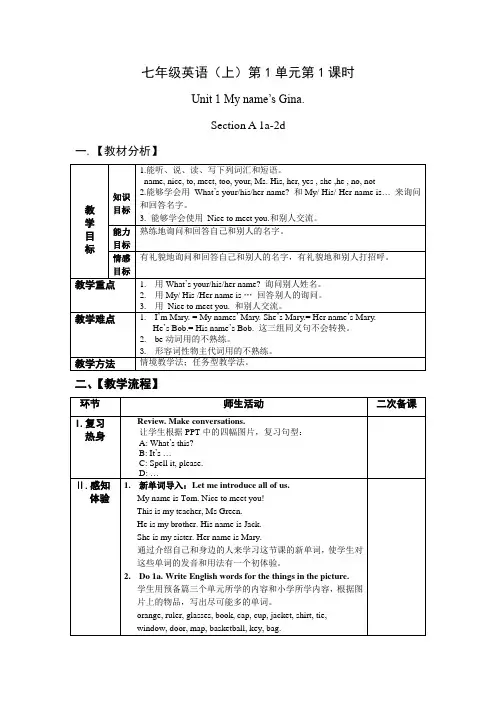
七年级英语(上)第1单元第1课时Unit 1 My name’s Gina.Section A 1a-2d一.【教材分析】二、【教学流程】环节师生活动二次备课I.复习热身Review. Make conversations.让学生根据PPT中的四幅图片,复习句型:A: What’s this?B: It’s …C: Spell it, please.D: …Ⅱ.感知体验1.新单词导入:Let me introduce all of us.My name is Tom. Nice to meet you!This is my teacher, Ms Green.He is my brother. His name is Jack.She is my sister. Her name is Mary.通过介绍自己和身边的人来学习这节课的新单词,使学生对这些单词的发音和用法有一个初体验。
2.Do 1a. Write English words for the things in the picture.学生用预备篇三个单元所学的内容和小学所学内容,根据图片上的物品,写出尽可能多的单词。
orange, ruler, glasses, book, cap, cup, jacket, shirt, tie,window, door, map, basketball, key, bag.教学目标知识目标1.能听、说、读、写下列词汇和短语。
name, nice, to, meet, too, your, Ms. His, her, yes , she ,he , no, not2.能够学会用What’s your/his/her name? 和My/ His/ Her name is…来询问和回答名字。
3. 能够学会使用Nice to meet you.和别人交流。
能力目标熟练地询问和回答自己和别人的名字。
情感目标有礼貌地询问和回答自己和别人的名字,有礼貌地和别人打招呼。
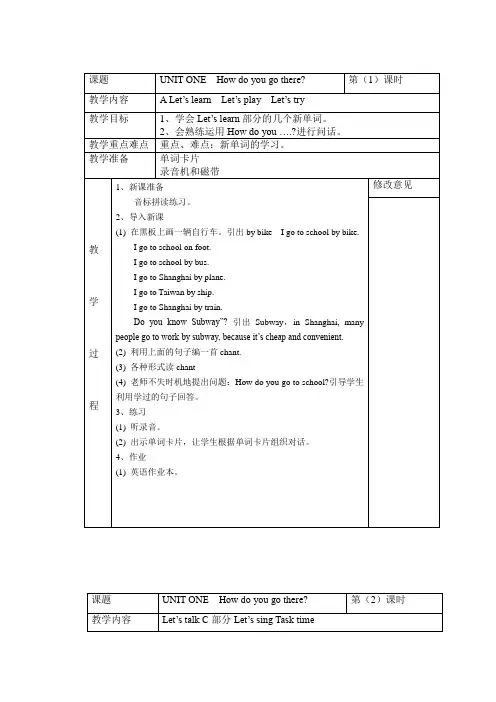
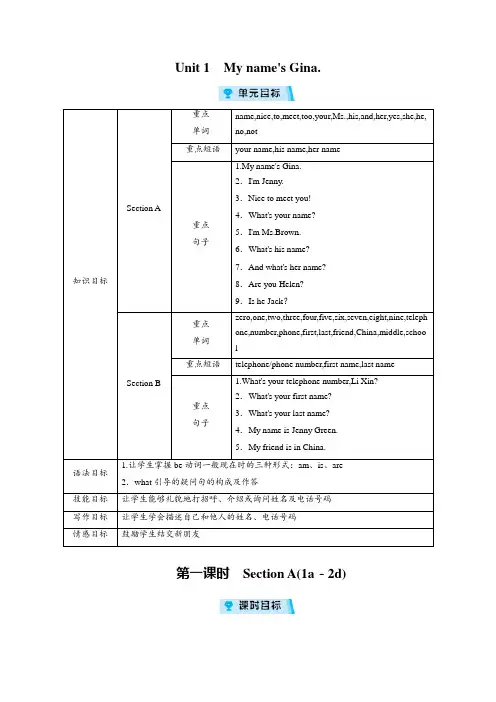
Unit 1My name's Gina.知识目标Section A重点单词name,nice,to,meet,too,your,Ms.,his,and,her,yes,she,he,no,not重点短语your name,his name,her name重点句子1.My name's Gina.2.I'm Jenny.3.Nice to meet you!4.What's your name?5.I'm Ms.Brown.6.What's his name?7.And what's her name?8.Are you Helen?9.Is he Jack?Section B重点单词zero,one,two,three,four,five,six,seven,eight,nine,telephone,number,phone,first,last,friend,China,middle,school重点短语telephone/phone number,first name,last name重点句子1.What's your telephone number,Li Xin?2.What's your first name?3.What's your last name?4.My name is Jenny Green.5.My friend is in China.语法目标1.让学生掌握be动词一般现在时的三种形式:am、is、are 2.what引导的疑问句的构成及作答技能目标让学生能够礼貌地打招呼、介绍或询问姓名及电话号码写作目标让学生学会描述自己和他人的姓名、电话号码情感目标鼓励学生结交新朋友第一课时Section A(1a-2d)重点单词name n. 名字;名称nice adj. 令人愉快的;宜人的to 常用于原形单词前,表示该动词为不定式meet v. 遇见;相逢too ad v. 也;又;太your pron. 你的;你们的Ms. 女士his pron. 他的and conj. 和;又;而her pron.她的yes interj. 是的;可以she pron. 她he pron. 他no ad v.& adj. 不;没有;不是not ad v. 不;没有重点短语your name 你的名字his name 他的名字her name 她的名字重点句子1.My name's Gina. 我的名字叫吉娜。
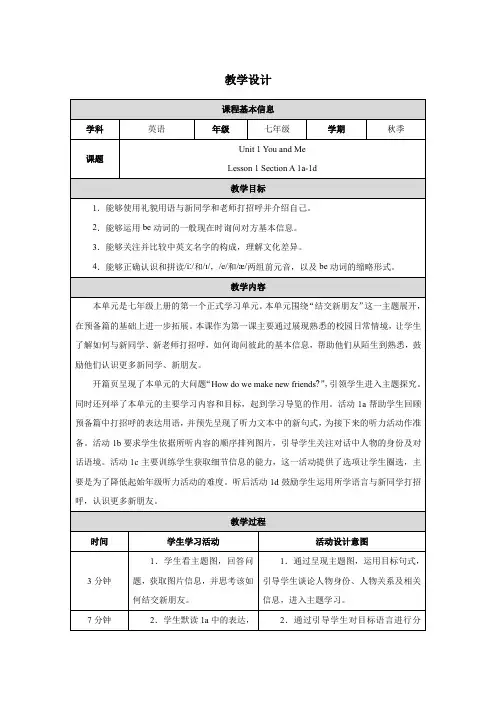
![PEP7Unit1(1)[1].教学设计](https://uimg.taocdn.com/ffa652e9b9f3f90f76c61be7.webp)
编写者陈欢第 1 教时内容Unit 1 How Do You Go There?设计理念词汇是开口用英语表达的基础,在这堂课中通过不同的方式呈现词汇,寓教于乐。
最后通过语篇的任务型教学,提高学生的语篇组织和运用能力。
课时教学目标1.能够听、说、读、写短语:by train、by plane、by subway、by ship、by bike、on foot。
2.能够听、说、认读句子:How do you go to …? 并能在实际情景中运用。
3.能够完成Task time中的任务。
教学重点听、说、读、写短语“by train、by plane、by subway、by ship、by bike、on foot”并能在实际情景中灵活运用。
教学难点1、理解词组“go back”与单词“subway”。
2、使用交通工具的表达。
教学资源各种地点的图片、交通工具的模型,单词卡片,表格,课件修改意见教学过程(一)热身(Warm- up)1.教师引导学生做第一册第64页的Let’s do。
(需借助多媒体,出示该段内容的字幕。
)Drive the car, throw the plane……2.日常口语对话: Good morning! Welcome back to school.Glad to meet you again.How are you? Fine, thank you.What’s the weather like today? It’s very hot.(二)预习(Preview)听听做做:要求学生能根据教师的指令,做出相应的动作,目的在于让学生理解本课时的教学难点“go back to…”。
Eg:1. Please go to the door. Open the door, please.(等学生完成指定任务后)Thank you. Go back to your seat, please.2.Please go to the window. Close the window, please.Thank you. Go back to your seat, please.(三)新课呈现,巩固操练( Presentation and practice)1. 教师引导,呈现新课。
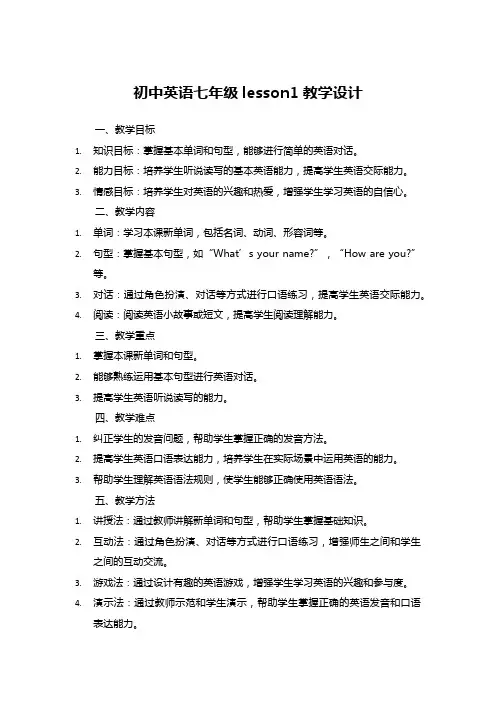
初中英语七年级lesson1教学设计一、教学目标1.知识目标:掌握基本单词和句型,能够进行简单的英语对话。
2.能力目标:培养学生听说读写的基本英语能力,提高学生英语交际能力。
3.情感目标:培养学生对英语的兴趣和热爱,增强学生学习英语的自信心。
二、教学内容1.单词:学习本课新单词,包括名词、动词、形容词等。
2.句型:掌握基本句型,如“What’s your name?”,“How are you?”等。
3.对话:通过角色扮演、对话等方式进行口语练习,提高学生英语交际能力。
4.阅读:阅读英语小故事或短文,提高学生阅读理解能力。
三、教学重点1.掌握本课新单词和句型。
2.能够熟练运用基本句型进行英语对话。
3.提高学生英语听说读写的能力。
四、教学难点1.纠正学生的发音问题,帮助学生掌握正确的发音方法。
2.提高学生英语口语表达能力,培养学生在实际场景中运用英语的能力。
3.帮助学生理解英语语法规则,使学生能够正确使用英语语法。
五、教学方法1.讲授法:通过教师讲解新单词和句型,帮助学生掌握基础知识。
2.互动法:通过角色扮演、对话等方式进行口语练习,增强师生之间和学生之间的互动交流。
3.游戏法:通过设计有趣的英语游戏,增强学生学习英语的兴趣和参与度。
4.演示法:通过教师示范和学生演示,帮助学生掌握正确的英语发音和口语表达能力。
5.探究法:通过引导学生自主探究,培养学生的自主学习能力和解决问题的能力。
6.小组合作法:通过小组合作的方式进行学习和交流,培养学生的合作意识和协作能力。
7.个性化指导法:针对不同学生的需求和问题,进行个性化的指导和帮助,帮助学生更好地掌握英语知识和技能。
8.教学媒体运用:利用多媒体教学工具,如PPT、音频、视频等,辅助教学进程,提高教学效果。
9.课堂评价与反馈:在教学过程中及时进行评价和反馈,帮助学生了解自己的学习情况并进行调整改进。
同时向家长反馈学生的学习情况,增强家校互动与合作。
10.课外辅导与拓展:通过课外辅导和拓展活动,如英语角、英语电影欣赏等,帮助学生巩固所学知识并拓展视野。
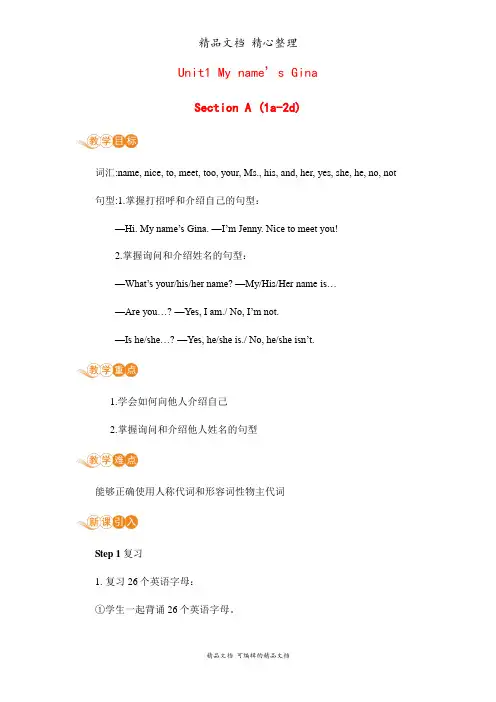
U nit1 My name’s GinaSection A (1a-2d)词汇:name, nice, to, meet, too, your, Ms., his, and, her, yes, she, he, no, not 句型:1.掌握打招呼和介绍自己的句型:—Hi. My name’s Gina. —I’m Jenny. Nice to meet you!2.掌握询问和介绍姓名的句型:—What’s your/his/her name? —My/His/Her name is…—Are you…? —Yes, I am./ No, I’m not.—Is he/she…? —Yes, he/she is./ No, he/she isn’t.1.学会如何向他人介绍自己2.掌握询问和介绍他人姓名的句型能够正确使用人称代词和形容词性物主代词Step 1复习1.复习26个英语字母:①学生一起背诵26个英语字母。
②在四线三格内书写26个英语字母大小写,请几名学生在黑板上书写,其他学生在本子上一同进行。
最后,教师评出几名书写最准确、工整的学生给予口头表扬。
2.复习句型:看图编对话,使用的图片尽可能地使学生运用所学句型,并请几组学生进行展示。
Step 2导入1.利用一些实物,通过“What’s this in English?”这一句型,来辨识与课本图中相关物品。
2.组织学生进行小组竞赛,将表示这些物品的英文单词写在黑板上。
每组可以多人次上来写,但不可重复。
比一比哪组写得最多最准确。
Step 3句型学习1.句型引入:教师通过再一次介绍自己,运用句型“My name is…”和“I am…”。
2.句型练习:①学习了“My name is…”句型后,教师依次向部分学生提问“What’s your name?”,让学生说出自己的名字,进行句型练习。
②邀请几列学生进行传句子比赛,看哪一列学生说得又快又清晰。
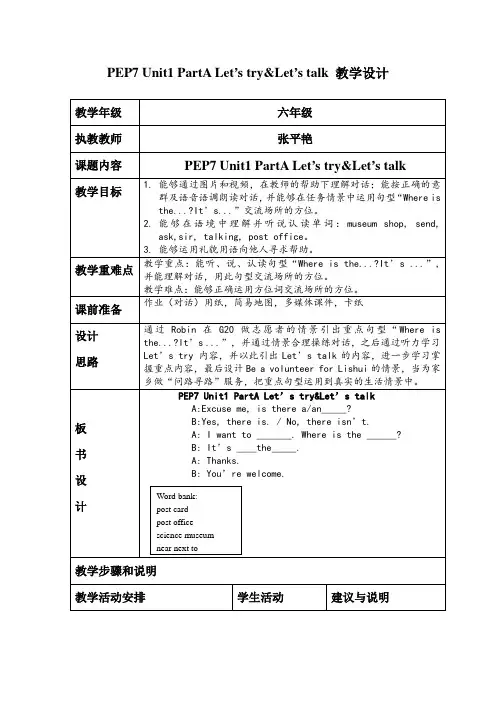
PEP7 Unit1 PartA Let’s try&Let’s talk 教学设计
热身环节,复习地点和方位单词,由这些单词组成一个机器人的模样,引出本节课主人公:Robin:a talking robot
设置情景:Robin 要做G20的志愿者。
为下面环节做铺垫。
设置问路场景和对话,通过两位游客的问路,学习新知识:post card& post office;并通过此情景操练句子: where
由此情景引出文中句型:don’t know. I’ll ask.
由book shop 切入引出museum shop。
由museum shop引出science museum。
通过观看博物馆里机器人的
设置听力,回答问题。
由What does Wu Yifan buy for Grandpa?导入 let’s try 正文,首先设置问题听听并回答问题,然后再进行课文填空,如下图:
设置生活中的情景,进行对话操练。
潜移默化中进行情感教育,如下图:。
Lesson 1(Section A 1a-1c)教学重点:1.掌握以下句式:How much is this T-shirt? It’s seve n dollar.How much are these socks? They are two dollars.2.掌握以下词汇:pant, sock, shirt, T-shirt, shorts, sweater, shoes, skirt, sale, dollar. (P41) 教学难点:使用how much引导的问句及回答。
一.课前准备:1. 在课文中找出下列新词汇用彩笔划下并标出汉语意思。
pant, sock, shirt, T-shirt, shorts, sweater, shoes, skirt, sale, dollar,2. 试着朗读1a里的对话,对新单词作注释。
二.课中学习:1.预习情况交流:以讨论的方式谈论物价,将学生谈论中出现的新单词写在黑板上。
T: What are these in English?S: They are bags/ hats/pants/socks/ shorts/ sweaters/shoes/pandas/ cars/and basketball…T: What do you like?S: I like red hats, green sweaters…T: How much are they?S: They are …2.呈现新句型并将生词用于句型中。
How much is this T-shirt? It’s seven dollars.How much are these socks? They are two dollars.3.以不同的方式操练新句型。
(pairwork /groupwork)For example: How much is this hat? It’s seve n dollar.What color is it? It is red.How much are these sweaters? They are thirty dollars.What color are they? They are green.4.以竞赛的方式让学生谈论书上的图片(1a)This is the picture of a clothes shop. What can you see in the picture?I can see ... . How much is it? / How much are they? It’s ... ./ They’re ... .5.实践运用。
My name’s Gina.Section A 单词name n. 名字;名称nice adj. 令人愉快的;宜人的to常用于原形动词之前,表示该动词为不定式meet v. 遇见;相逢too adv. 也;又;太your pron. 你的;你们的Ms. (用于女子的姓氏或姓名前,不指明婚否)女士and conj. 和;又;而his pron. 他的her pron. 她的yes interj. 是的;可以she pron. 她he pron. 他no adv. & adj. 不;没有;不是not adv. 不; 没有短语your/his/her/my name你的/他的/她的/我的名字句型1. —What’s your/his/her name? 你的/他的/她的名字是什么?—My/ His/ Her name is…我的/他的/她的名字是……2. —Nice to meet you. 见到你很高兴。
—Nice to meet you, too. 见到你我也很高兴。
Section B 单词zero num. 零one num. 一two num. 二three num. 三four num. 四five num. 五six num. 六seven num. 七eight num. 八nine num. 九telephone n. 电话;电话机phone n. 电话;电话机number n. 号码;数字China 中国friend n. 朋友middle adj. 中间的n. 中间last adj. 最后的;末尾的first adj. 第一school n. 学校短语first name 名字middle school 中学;初中last name 姓in China在中国telephone/phone number 电话号码句型—What’s your telephone number? 你的电话号码是多少?—It’s…它是……语法1. 连系动词be的用法2. 形容词性物主代词知识目标掌握形容词性物主代词。
PEP小学英语六年级上册第一单元教学预案
课时标题
Unit1 How can I get there?
A Let’s learn \\ make a map and talk
课时第一课时
教学目标1.知识目标:Be able to understand , read and write the words “ science museum, post office, bookstore, cinema and hospital” 能在确定的场景中进行熟练运用. Where is the cinema? It’s next to the bookstore.
2.能力目标:Be able to understand and use the words “ near, next to, in front of, behind, beside,” to located some places.
3.情感目标:培养学生生活中的方向感.
教学重点能够听说读写单词science museum, post office, bookstore, cinema and hospital” 并能在确定的场景中进行熟练运用. Where is the cinema? It’s next to the bookstore.
教学难点
方位词near, next to, in front of, behind, beside的理解,区分
和运用.
板书设计
Unit1 How can I get there ?
Where is the …?
It’s next to/ near/ behind/ in front of….
教学过程建议与
感谢您的阅读,祝您生活愉快。
pep7 unit1 第一课时(全英)教案Lesson plan for lesson 1 of pep7 unit1
pep7 unit1 第一课时(全英)教案
前言:小泰温馨提醒,英语作为在许多国际组织或者会议上都是必需语言,几乎所有学校
选择英语作为其主要或唯一的外语必修课。
英语教学涉及多种专业理论知识,包括语言学、第二语言习得、词汇学、句法学、文体学、语料库理论、认知心理学等内容。
本教案根据
英语课程标准的要求和针对教学对象是小学生群体的特点,将教学诸要素有序安排,确定
合适的教学方案的设想和计划、并以启迪发展学生智力为根本目的。
便于学习和使用,本
文下载后内容可随意修改调整及打印。
课题a .let’s read c good to know pronunciation第 1 课
时目标
1、能听说读写短语:on foot , by bike , by bus , by train .
2、能听说认读短语: by plane , by ship , by subway .
3、能用句子: “how do you go to school? how do you
go tocanada\…”来替换关键词询问别人的出行方式;并能用句子”i go by …”进行回答。
4、能听懂、会吟唱let’s chant的歌谣重点难点key points: four-skill phrases and the two
sentences.difficult points: use the phrases and the sentences in activities准备tools: card tape ss: cards教学过程教师活动学生活动step1 warm up
1.free talkt:today i go to schooj by bus . usually
i go to school by bike. do you go to school by bus ? or
by bike\on foot \?
2.show the pictures of the vehicles : bike , bus ,
car ,train…
1.ss:i go to school by
2.to know the new words. step2preview
1.let’s chant
2.let’s sing . how do you go to
school?3 .practice 4 . let’s try. play the cassette
1.chant it with the cassette
2.sing together.
3.s ; i go to school -----.in pairs ,two ss ask and answer.
4.listen and choose the right picture.
step3presentation1 . show a toy bike and ask : “how do
i go to school, do you know?” then tell the
ss: “ usually i go to school by bike.” write the sentences on the blackboard. “i go to school by bike.”2 . teach other phrases in the same way
3.show the pictures, then ask:t: how do you go
to ? 4 .play a gamet: by bike 5 .play the cassette 6 .write the phrases and the
sentences. 7 .play a game
1.repeat it . 2 . look and say:i go to
school 3 .look at the picture and answer the questionsss: i go to by .4 . listen do and sayshow the the picture and say::i goto school by
bike ,5 .
(1)listen to the tape,point the phrases.
(2)listen to the tape ,read after the tape6 .write them on the exercise book.7 .in pairs,choose the cards
and say: i go to by . step4consolidation and extension1 .finish the exercises in the activity
book 2 .write the phrases and the sentences on the exercise book.3 .learn to sing:” how do you go to school?”listen and match./listen and write.sing the song. 板书how do you go to ?i go
to by .on foot , by bike , by bus , by train . by plane , by ship , by subway
-------- Designed By JinTai College ---------。